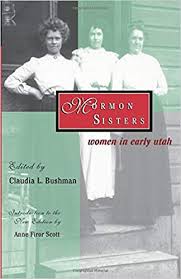Articles/Essays – Volume 10, No. 4
Taking Them Seriously | Claudia L. Bushman, ed., Mormon Sisters: Women in Early Utah
Edited by Claudia Lauper Bushman, founder of Exponent II, Mormon Sisters covers sizeable ground: articles about women as mystics and healers, midwives, schoolteachers, politicians, feminists; selections dealing with individual women (like Eliza Snow and Susa Young Gates); analyses of women as characters in Mormon fiction. Although the quality of the writing is uneven, the book is certainly scholarly enough for the classroom, readable enough to be enjoyed by those long absent from the classroom and important enough to be read by all Mormons. I would welcome Mormon Sisters even if it were no better than mediocre in style and technique. Happily, it is better than that. Now the question is, “How may it best be used?”
Bushman begins her preface by explaining that the book emerged after a group of Mormon women “began to meet together to discuss their lives.” For LDS women who have been thinking off and on about meeting with other women and “discussing their lives,” Mormon Sisters offers a fine point of departure. (Given our cultural shibboleths, it is easier to tell friends you are going to a “study group” than to a “consciousness-raising session.”) Such a study group might begin with Judith Rasmussen Dushku’s “Feminists/’ pausing on such statements as “Neither vicarious influence nor coat-tail salvation was sufficient for the Latter-day Saint woman,” or “Emmeline Wells was particularly concerned with the constraints of the pedestal.” Or they might ponder together “Fictional Sisters,” by Laurel Thatcher Ulrich, who catalogues Mormon women in early fiction as Earth Mothers, Amazons, Pandoras, or Virtuous Victims.
But the study group is only one unit that might profit from Mormon Sisters. Families, especially those with daughters, could use this book as a source of models of faithful Church women, enriching family home evening by giving their girls details from the lives of women who exemplified the highest gospel standards. Similarly, anyone planning a church talk could draw upon the book for fresh examples and faith-promoting stories about women. Currently, most of our stories and anecdotes in church meetings are about men simply because we have not had available in any detail the history of our women.
The book could be used to a similar end in Primary classes, and in Young Women’s classes, when examples of faith, courage, perserverance and sisterly kindness are required. Relief Society “mini-classes” or other lessons built around the history of our pioneer foremothers seem not only appropriate but overdue. Seminary and institute classes in Church History and other subjects surely need to be updated to include material such as that found in Mormon Sisters.
Youth conferences, and in particular, Young Women and combined YW Relief Society conferences could plan meaningful workshops around one or several of our great early-day women, or around a theme suggested by this material. Mormon Sisters, with its small fortune of information, would allow workshop leaders in such cases to “get beneath the sunbonnets,” to use Maureen Ursenbach Beecher’s expression—to flesh out the heretofore one dimensional pictures we have had of these early sister saints.
And certainly a number of college courses, particularly but not exclusively taught at BYU, Ricks, and the BYU-Hawaii campus, not only could but ought to investigate the possibility of using Mormon Sisters. Classes dealing with Western American History, the settlement of the West; classes of all sorts in women’s studies; literature courses dealing with Western Literature—all of these have a responsibility to take into account the role and contribution of the 19th century Mormon woman. Certainly Mormon Sisters is not a definitive text for such classes but it is a place to start, a reference point. With its useful Chronology, Reading List, and Bibliography of Mormon Novels, it is assuredly a helpful tool.
Claudia Bushman and her Boston circle of “Mormon Sisters” have made an important contribution to our LDS culture. Perhaps their claim to have “made history while making history” overstates the case just a bit, but at this point in our history I believe we will lose more by underestimating, rather than overestimating, the significance of this work. I hope Dialogue readers give serious thought to studying the book, and to using it in some of the ways suggested, or in ways of their own devising. Only such a response will convince Bushman & Co. and other prospective writers that we, like Leonard J. Arrington, “take them seriously”; only such a response will assure us that other books on this crucial subject will be forthcoming.
Mormon Sisters: Women in Early Utah Emmeline Press Limited: Cambridge, Mass. 1976. 283 pp, including index. Hardback $7.95 and Paperback $4.95.


 Back to full Issue
Back to full Issue

